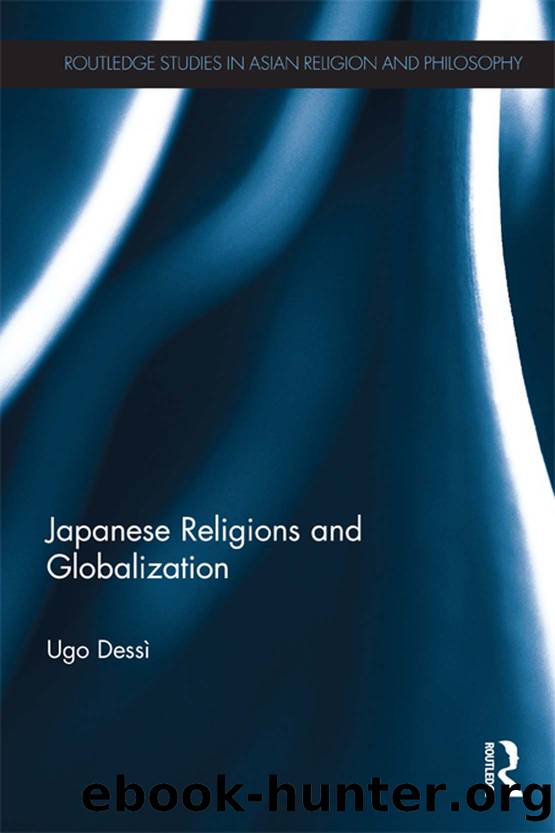Japanese Religions and Globalization by Dessì Ugo; Dessì Ugo;

Author:Dessì, Ugo; Dessì, Ugo;
Language: eng
Format: epub
Publisher: Taylor & Francis Group
The same concept is reaffirmed by Umeda Yoshimi (1933â2010), the late director general of the ShintÅ Kokusai Gakkai, with reference to the dynamics of contemporary society. In a world that is âsteadily becoming globalized,â he affirms, Japan must âopen the door to its secluded regions,â and give access the international community to what lies âbeyond the wall of State Shinto.â According to Umeda, this serves for the âinternationalization of Japanâ and the âawareness of Japan in the worldâ (Umeda 2009: 1).
In order to pursue these goals, the ShintÅ Kokusai Gakkai promotes activities such as lectures, conferences, publication of books, religious and cultural events outside Japan, and an Annual ShintÅ Essay Competition. Similarly to the BukkyÅ DendÅ KyÅkai, the ShintÅ Kokusai Gakkai has also been sponsoring, since 1997, the establishment of university chairs focusing on âShinto as the core of Japanese cultural valuesâ in various countries. The first of these was endowed at the University of California, Santa Barbara, and has been followed by others at Zhejiang University, the aforementioned London University School of Oriental and African Studies, and Columbia University (International ShintÅ Foundation 2009b). The latter chair is funded through the Toshu Fukami Professorship, named for Fukami TÅshÅ« (b. 1951), the current president of the ShintÅ Kokusai Gakkai and controversial leader of the ShintÅ-based new religious movement Worldmate (WÄrudomeito).3 Through these academic activities, and the collaboration of well-known scholars of Japanese religions, the foundation has been able to enhance to some extent the visibility of ShintÅ at the international level. As is clear from the discussion above, in the ShintÅ Kokusai Gakkai's intentions, information provided to the international public should preferably focus on ShintÅ as âthe core of Japanese cultural values,â and emphasize aspects that are not related to State ShintÅ. It is obviously very difficult to verify to what extent this agenda has been successful. In principle, as suggested above in the case of the BukkyÅ DendÅ KyÅkai, it is always possible that some conflict with the secular interests of an academic endeavor may arise. That this may also happen in practice has been suggested by Klaus Antoni, according to whom some academic research on ShintÅ published by members of the ShintÅ Kokusai Gakkai may correspond âto the aims of this foundation to free the image of Shinto from all political contamination.â 4 Be it as it may, this issue tells us something else about cultural flows, namely, that globalization is also a history of omissions. Within global dynamics, cultural and religious elements do not simply cross borders, glocalize, and hybridize, but also undergo preemptive processes of selection before (and after) being entered in these flows, and are thus potentially eligible to contribute to the agendas of global players interested in strengthening their prestige and cultural power.
Download
This site does not store any files on its server. We only index and link to content provided by other sites. Please contact the content providers to delete copyright contents if any and email us, we'll remove relevant links or contents immediately.
The Story of China by Michael Wood(929)
Mr. Selden's Map of China by Timothy Brook(775)
Philippines--Culture Smart! by Culture Smart!(669)
Heroic Hindu Resistance To Muslim Invaders (636 AD to 1206 AD) by Sita Ram Goel(657)
Akbar: The Great Mughal by Ira Mukhoty(651)
The Meaning of India by Raja Rao(631)
Vedic Physics: Scientific Origin of Hinduism by Raja Ram Mohan Roy(624)
Food of India by unknow(618)
Banaras by Diana L. Eck(614)
India--Culture Smart! by Becky Stephen(602)
China Unbound by Joanna Chiu(602)
First Platoon by Annie Jacobsen(601)
Mao's Great Famine: The History of China's Most Devastating Catastrophe, 1958-1962 by Frank Dikötter(594)
North of South by Shiva Naipaul(591)
Insurgency and Counterinsurgency by Jeremy Black(564)
How to Be a Modern Samurai by Antony Cummins(563)
A History of Japan by R.H.P. Mason & J.G. Caiger(562)
The Genius of China: 3,000 Years of Science, Discovery, and Invention by Robert Temple(562)
The Digital Silk Road by Jonathan E. Hillman(550)
